14-21 January 2013. Chong Khneas is a floating village on Tonle Sap Lake. Since it is the closest floating village to the major tourist mecca of Siem Reap, and the most accessible, it too has become a tourist destination. We’d read that it has become a bit of a show put on for the tourists, and that there’s various scams going on if you take a tour there. Our friend Paula said we could just go rent our own boat and have the boatman take us around the village but in the end we chose not to do that. We’d also read that you could stay overnight at Prek Toal Bird Sanctuary and we wanted to do that so we could get up early for the “dawn chorus” which is the best time to see the birds. Our friend Don at Bliss Villa called the contacts he had there and apparently it was not possible to stay overnight, but he could organize a day trip for us – to the bird sanctuary, and to Prek Toal floating village.
There’s a canal that runs from Siem Reap down to the lake. Here on the canal in the early morning light everyone gets ready to head out for the day
while kids play amongst the fish traps.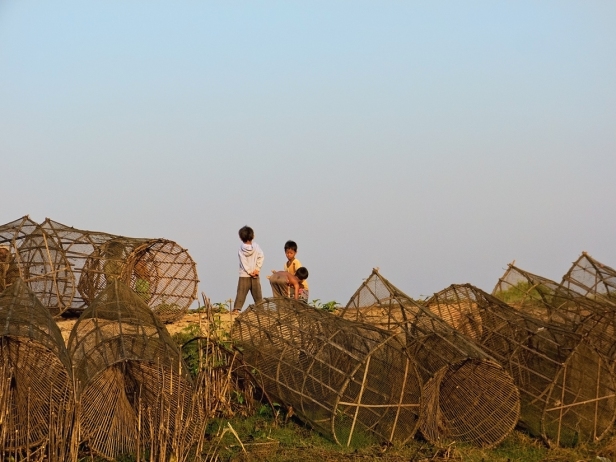
We head down to, then across the lake, and down a channel into the marshlands. The channel gets narrower and narrower until we are completely surrounded by foliage and it becomes almost impossible to know which way to go. It is a slow journey heading deeper and deeper into the marshlands. Cormorants, pelicans, egrets, a fish eagle and teeming hoards of white-winged birds, all take flight as we cruise by. The sun is shining, the air is clear, we have nothing to do but enjoy the beautiful natural surroundings and the birds putting on a display for us. We are happy.
Somewhere in the swamp

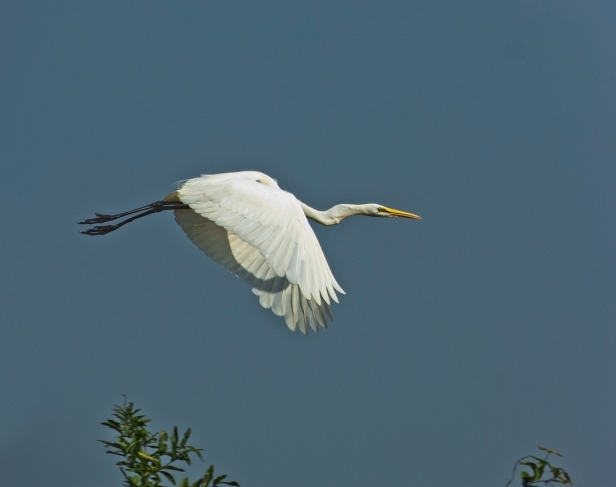

Don’s photo – pelicans and a cormorant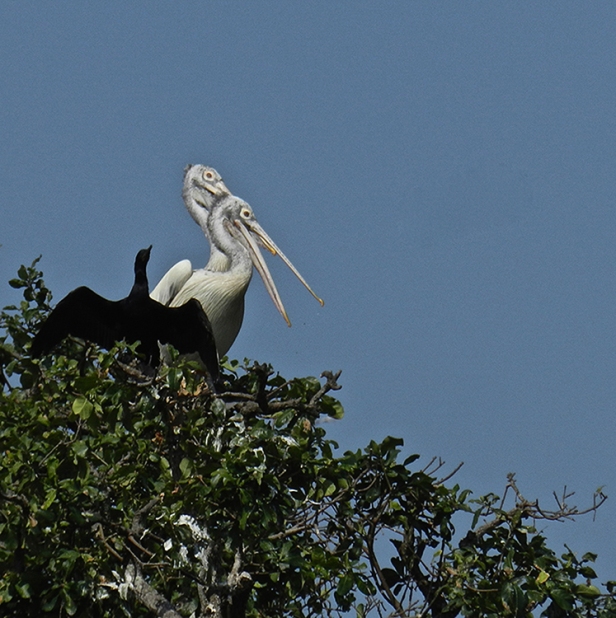
Turning the boat around. At this time of year the water is very shallow.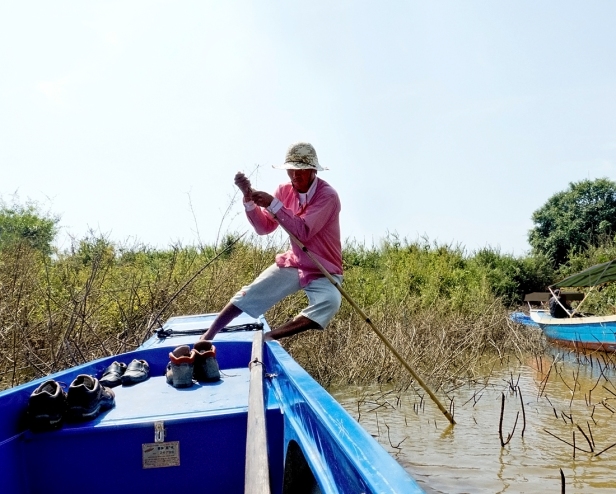
Returning to the lake we come to Prek Toal village
where we are rowed around in a small wooden boat, much like this one.
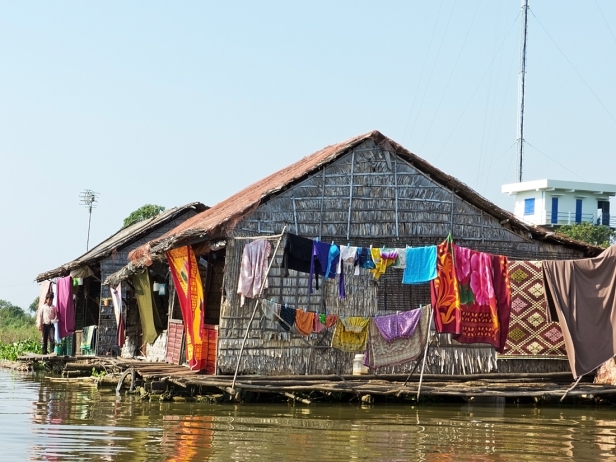

The village dress shop – so people don’t have to go all the way into Siem Reap when they need new clothes.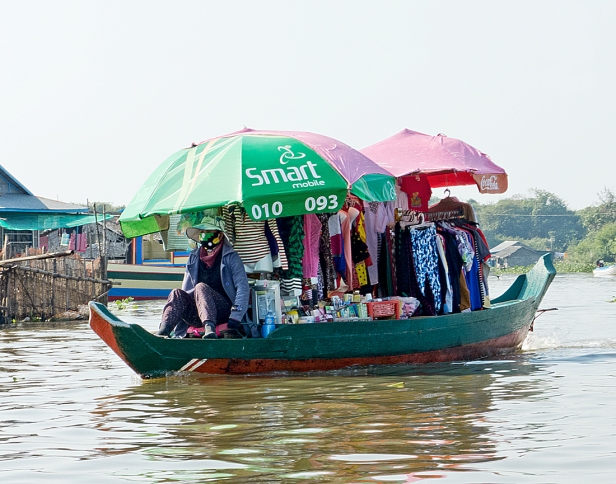
We are shown a crocodile farm. The crocodiles are held in a cage in the water directly next to the owner’s floating house – right there by the living room under the deck. They do not seem to be in any kind of distress. The owner makes a good living raising crocodiles and selling them for their skin. So next time you buy a crocodile belt or purse or shoes you’ll know the skin probably came from a farm somewhere in Southeast Asia. We also saw a crocodile farm in Vietnam. Imagine that for a life – living in a floating house in a lake in the tropics. The water level in the lake rises and falls by many meters with the change from the dry season to the wet, affecting pretty much everything. And you make a comfortable, if not ostentatious, living raising crocodiles next to your living room. Not something I’d ever imagined really.
Water hyacinth is a free floating aquatic plant native to tropical South America. It’s an invasive plant in the waters of Southeast Asia and we saw it everywhere. If the darn stuff is going to grow like weeds, literally, and astonishingly it doubles its population every two weeks, you’d better be finding a use for it.
These women are going to harvest it.

The stems, about two feet long are dried and used to weave hats, baskets, bags, boxes, furniture, footwear, and floor mats. Another thing I’d not have imagined – that the short stems of a water plant could be used in such a practical and beautiful way. We were really impressed with the quality of the work. People amaze me with their creativity!
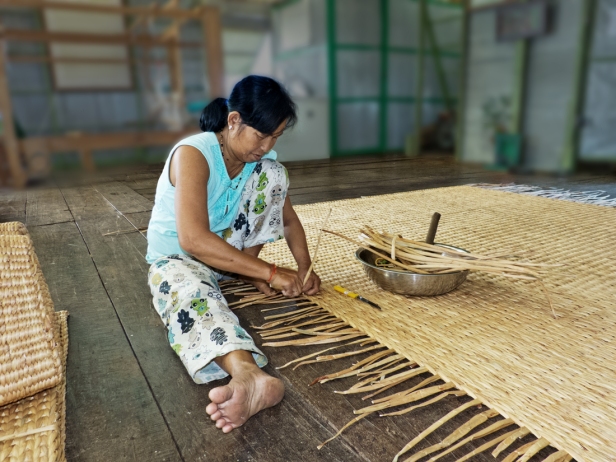
About fifty kilometers from Siem Reap – village life at Phnom Kulen
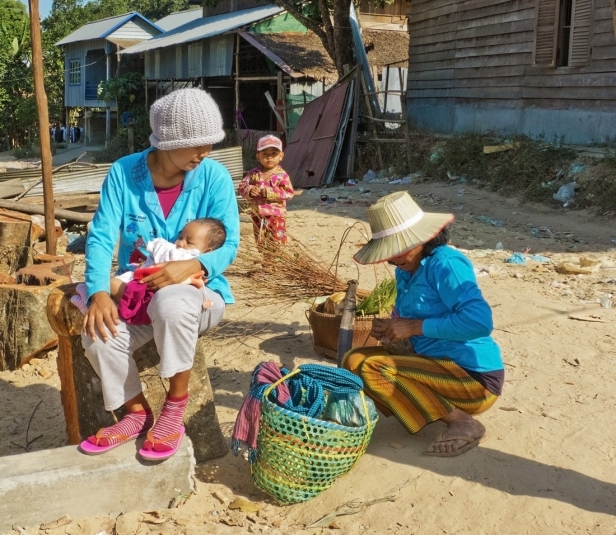


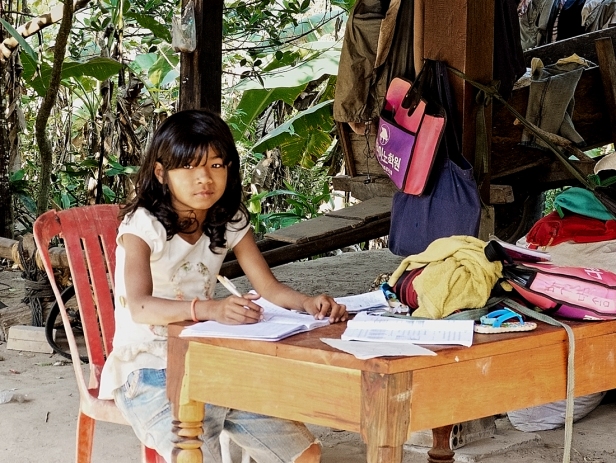

Almost everyone in Cambodia has a motorbike. Well everyone who can afford any vehicle at all. Few can afford cars. Motorbikes are much cheaper to buy, and use far less gas. This is a Cambodian gas station – a great way to recycle all those whiskey bottles.

At the temple on Phnom Kulen, a sacred mountain
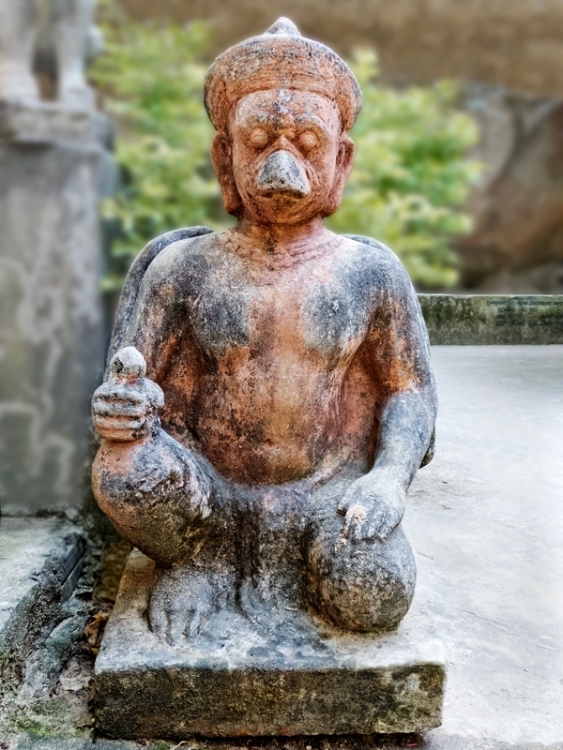


On the way home we stopped at the palm sugar village. The entire village seemed to be involved in the production of palm sugar. I’d only tasted palm sugar once, and had never heard of it before coming to South East Asia. Here we got to try some candies, and to see how it was made – a long laborious painstaking process. They shimmy up the palm tree and put a nick in the end of each long ‘branch’ of the palm flower, and then put a bamboo container over each flower branch and collect the ‘sap’, which is then heated slowly in huge wok-like vessels over equally huge mound-like concrete fire pits, for hours, and then stirred, for hours. Eventually you end up with palm sugar, and palm sugar candies. Very like maple candy and really good. There’s also palm fruit that comes in a big purple ball and the inside looks a bit like mangosteen but without the lovely taste.
Stirring the liquid sugar
Peeling palm fruit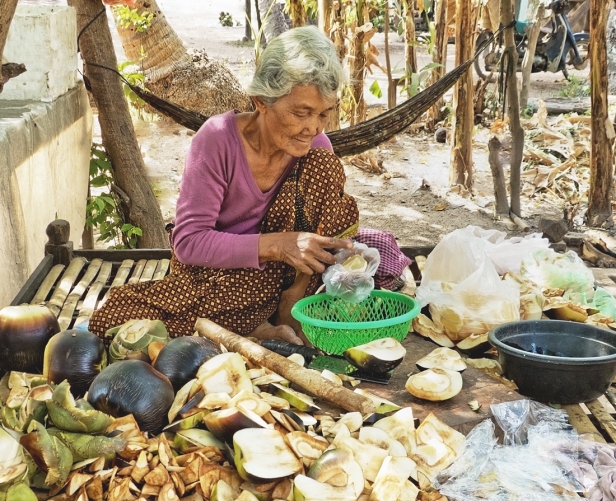
Selling palm candies
And so we came to the end of our time in Siem Reap, and the end of our time in Cambodia. We flew from Siem Reap to Vientiane and a began whole new adventure in Laos. More to come in the next post.
All words and images by Alison Louise Armstrong unless otherwise noted.
© Alison Louise Armstrong and Adventures in Wonderland – a pilgrimage of the heart, 2010-2015.

so interesting thank you! and great photos.
LikeLike
Thanks 🙂
My pleasure.
LikeLike
Wow, Alison, quite a tour of things I have never heard or thought about–crocodile farms, palm sugar factories, water hyacinth weaving. Love the photos. {{{hugs}}} Kozo
LikeLike
SE Asia is a really amazing place – so many cottage, I mean village, industries. It’s fascinating, and it’s one of the big things that keeps me travelling. I’m apparently endlessly enthralled by the inventiveness of people, and the ways they find to make life work, even in the most basic circumstances.
Thanks re the photos
Hugs from me
xoxox
LikeLike
Wonderful post. Fabulous photos.
LikeLike
Thanks 🙂
❤ ❤ ❤
LikeLike
Thanks again for sharing your adventures and beautiful pictures!
LikeLike
My pleasure, and thank you. Glad you enjoyed it.
LikeLike
been thr….great country…massive temples…but missed the palm sugar candy industry
LikeLike
Yes, the temples are amazing aren’t they. There’s much to love about Cambodia.
I think we stumbled into the palm sugar village by accident. We mentioned to our driver that our friend in Siem Reap wanted some palm fruit and he knew where to go to get it. There’s a whole long row of stalls next to the road (with the village behind) where they make, and sell the candies. It was really interesting.
LikeLike
another thing is about the huge lake of Tonle Sap…love the community there…especially the kids…they are cute (rowing in a bucket, snake as a pet..etc) 🙂
LikeLike
Yes we saw lots of very cute kids. They mostly seemed bright and happy.
LikeLike
I enjoyed reading this, thanks. One day I’d love to follow in your footsteps.
LikeLike
Thanks Danny. Hope you get there one day. It’s worth it for sure.
LikeLike
Alison, we spent several weeks in Cambodia last year, and in hindsight, I wish we would’ve gone to the floating villages around Tonle Sap too. It’s nice to travel there with you in spirit now. Happy that I discovered your site by way of Terri and James at Gallivance. 🙂
These bird images are impressive!
LikeLike
Hi Tricia, nice to meet you. I’ve been following Terri and James for a while now, and glad to get the advice (theirs and yours) about apartments.
Yes the floating villages were fabulous. The post Cambodia Part 2 is also about a Tonle Sap floating village that we reached from Phnom Penh.
Thanks re the photos – frequently just very good luck 🙂
And thanks for the follow.
Scooting off now to explore your blog.
Cheers
Alison
LikeLike
This is not a mere travel blog,at all. Your commentary does not judge and the photography speaks for ityself, but it is what you see that amazes me – focusing on the water hyacinth carpets and baskets was a wonderful example. What a waste that European culture goes on buying plastic carrier bags en masse in shops. It is criminal -it really is, not just used as an adjective. I opened a shop in Finland some years back; Finland, self-proclaimed ‘green’ country. Called Romany Secrets, it sold all manner of ethnic goods, and jute bags, which I made a point of selling cheaply to debunk this ‘chic’ ethnic goods concept. Barely 1 jute bag sold. Ok, Finland IS a country of sheep, none in fields, but still, for 4 Euro a strong, nice jute bag against some fake leather or other rubbish> Nope. I despair, and had only disgust for customers who accused me of ‘using’ child labour in India -probably one reason why they would not buy jute. No anger there by the way,just like strong words!
I found the picture of the monk in the boat stunning. I have mixed feelings about the monks and their role in society. I thought their presence in Laos was not wholly positive to be honest, and this picture also gives me mixed emotions.
I think I’d like to use some pictures of yours for a post on water hyacinth – referred back to of course.
Also,letme find a picture of yours to write a poem. I did with Gunta twice,with haiku also, was fun. I don’t like poetry and do not think my poems are worth the words they took, but as you wrote nice things will try again!
LikeLike
Your poems are worth the words they took!
Thank you so much for your kind words. Interestingly you’re the second person in a week to tell me that one of the reasons they appreciate my blog is that I don’t judge. It’s true I don’t. Never-mind that I get hurt and or angry or irritated the same as anyone, I have this underlying huge love for humanity (yes even for your ‘idiot’ Finns who can’t see the value of a good jute bag, and even for worse) and (call me Pollyanna if you like) a huge faith that people do the best they can. Given that, I see, and am buoyed by, the amazing inventiveness and creativity of people; the ways they find to make life work. I don’t know how to explain it, even to myself. I just know it’s endlessly thrilling – not the straightened circumstances, but the inventiveness with which people deal with it.
I’m sorry to hear your Romany Secrets could not find a welcome in Finland, and that you of all people (from what I know of you) would be accused of using child labor. It says a lot about the Finns, and must have very frustrating. Vancouver would have been a much more receptive place. I think probably a majority of people in Vancouver now take their own shopping bags. And in Canberra non-biodegradable (ie plastic) bags have been banned. Finally! The good news is a Japanese inventor has invented a machine that will turn *all* kinds of plastic back into oil to be reused.
I must admit I didn’t look deeply into the role of monks in Cambodia or Laos, except to understand that they are given (by even the poorest) all they need to live comfortable lives in the hopes of receiving a good reincarnation. I have very little time for any religion that proscribes behaviour in return for some future nebulous reward (and Buddhism is as bad as any other). Still, I find the monks exotic, and had a beautiful conversation with a couple of monks in Chiang Mai, and with another in Mandalay.
I’d be delighted for you to use any of my photos for haiku/poetry, and for a post on water hyacinth.
BTW I did note your rant about copyright 🙂
It all started with the photo of the sadhu with the spike through his tongue in the India Part 11 post. I was told I could sell it for a lot of money. Haven’t looked into it yet, but don’t want anyone to steal it from me 🙂
LikeLike
Here’s cause you don’t judge! A short ‘poem’ of sorts. http://yepirategunn.weebly.com/1/post/2013/04/samarkand-hotel.html#.UX-K3bWePc8
LikeLike
The part about water hyacinth and the village dress shop was Interesting !
LikeLike
Thanks 🙂
People always seem to find wonderfully creative and inventive ways to make life work, and to make a living. And I always seem to find it endlessly fascinating – keeps me travelling on.
LikeLike
Siem Reap is not all about the temples and the floating villages is always a great way of splitting your time in Siem Reap. Could you really live the way that these people do?
Either way they seem so happy what ever worries I am sure they have.
And some wonderful wildlife photos as well
LikeLike
No, I don’t think I could live the way these people do – I acknowledge that although I’m quite “tough”, and live comfortably with very little, I’m a pampered westerner who was raised in an entirely different lifestyle. I also think that apart from basic survival issues (clean water, food and shelter) the lack of which can be soul-destroying, people find happiness and creativity in a great variety of ways. It fills me with joy.
LikeLike